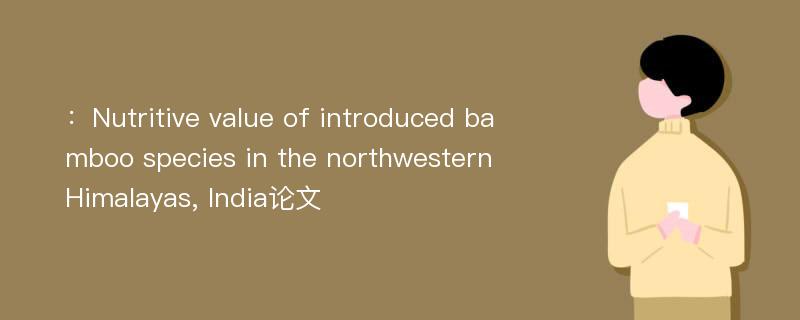
本文主要研究内容
作者(2019)在《Nutritive value of introduced bamboo species in the northwestern Himalayas, India》一文中研究指出:Bamboos are used extensively for a variety of purposes, and many new species have been introduced to the northwestern Himalaya. However, their potential as a fodder species has not been investigated. Six bamboo species, namely Dendrocalamus hamiltonii Gamble, Dendrocalamus asper(Schult. and Schult.f.) Backer ex K.Heyne, Melocanna baccifera(Roxb.) Kurz, Phyllostachys aurea Riviére and C. Riviére, Phyllostachys bambusoides Sieb and Zucc. and Phyllostachys pubescens(Pradelle)Mazel ex J. Houz. were evaluated for their nutritional value, relative palatability and best lopping time. Dry matter(DM), ether extract(EE), and crude fibre varied from(37.0–67.7)%,(4.7–7.6), and(22.1–37.9)%, respectively. Values of crude protein ranged from(12.2–17.1)%,total ash(TA) from(11.8–21.5)%, acid insoluble ash(AIA)from(0.3–0.5)%, nitrogen free extract from(31.1–40.8)%,carbohydrates from(57.0–69.0)%, organic matter(OM) from(78.5–88.2)%, calcium from(1.7–2.3)%, phosphorus from(0.4–0.8)%, potassium from,(0.9–1.6)%, magnesium from(0.5–0.9)%, sodium from(603.7–1072.7) 9 10-6 and vitamin A from(21.1–30.5) 9 10-2 mg/g, respectively. D.hamiltonii had maximum values for DM, EE, TA and AIA.OM and vitamin A were highest in M. baccifera. CF and carbohydrates were maximized in P. aurea and CP in P.pubescens. All the values obtained for different bamboo species were less than maximum tolerable concentration of common feed resources of the region thereby indicating their suitability for nutrition and palatability. The contents of anti-nutritional factors, namely hydrocyanic acid and tannin ranged from(33.8–61.7) 9 10-2 mg/g and(0.7–1.9)%, respectively. P. pubescens was the best species from a palatability point of view and has maximum crude protein content(17.2%), Ca(2.3%) and lowest tannin content(0.7%). The relative palatability of introduced bamboo species followed trend: P. pubescens(97.6%) [ D. hamiltonii(92.5%) [ P. bambusoides(81.2%) [ D. asper(76.9%) [ M. baccifera(75.9%) [ P.aurea(73.4%). The optimum months for lopping these species for green leaves are November and December, as the nutritional value declines sharply thereafter.
Abstract
Bamboos are used extensively for a variety of purposes, and many new species have been introduced to the northwestern Himalaya. However, their potential as a fodder species has not been investigated. Six bamboo species, namely Dendrocalamus hamiltonii Gamble, Dendrocalamus asper(Schult. and Schult.f.) Backer ex K.Heyne, Melocanna baccifera(Roxb.) Kurz, Phyllostachys aurea Riviére and C. Riviére, Phyllostachys bambusoides Sieb and Zucc. and Phyllostachys pubescens(Pradelle)Mazel ex J. Houz. were evaluated for their nutritional value, relative palatability and best lopping time. Dry matter(DM), ether extract(EE), and crude fibre varied from(37.0–67.7)%,(4.7–7.6), and(22.1–37.9)%, respectively. Values of crude protein ranged from(12.2–17.1)%,total ash(TA) from(11.8–21.5)%, acid insoluble ash(AIA)from(0.3–0.5)%, nitrogen free extract from(31.1–40.8)%,carbohydrates from(57.0–69.0)%, organic matter(OM) from(78.5–88.2)%, calcium from(1.7–2.3)%, phosphorus from(0.4–0.8)%, potassium from,(0.9–1.6)%, magnesium from(0.5–0.9)%, sodium from(603.7–1072.7) 9 10-6 and vitamin A from(21.1–30.5) 9 10-2 mg/g, respectively. D.hamiltonii had maximum values for DM, EE, TA and AIA.OM and vitamin A were highest in M. baccifera. CF and carbohydrates were maximized in P. aurea and CP in P.pubescens. All the values obtained for different bamboo species were less than maximum tolerable concentration of common feed resources of the region thereby indicating their suitability for nutrition and palatability. The contents of anti-nutritional factors, namely hydrocyanic acid and tannin ranged from(33.8–61.7) 9 10-2 mg/g and(0.7–1.9)%, respectively. P. pubescens was the best species from a palatability point of view and has maximum crude protein content(17.2%), Ca(2.3%) and lowest tannin content(0.7%). The relative palatability of introduced bamboo species followed trend: P. pubescens(97.6%) [ D. hamiltonii(92.5%) [ P. bambusoides(81.2%) [ D. asper(76.9%) [ M. baccifera(75.9%) [ P.aurea(73.4%). The optimum months for lopping these species for green leaves are November and December, as the nutritional value declines sharply thereafter.
论文参考文献
论文详细介绍
论文作者分别是来自Journal of Forestry Research的,发表于刊物Journal of Forestry Research2019年06期论文,是一篇关于,Journal of Forestry Research2019年06期论文的文章。本文可供学术参考使用,各位学者可以免费参考阅读下载,文章观点不代表本站观点,资料来自Journal of Forestry Research2019年06期论文网站,若本站收录的文献无意侵犯了您的著作版权,请联系我们删除。
